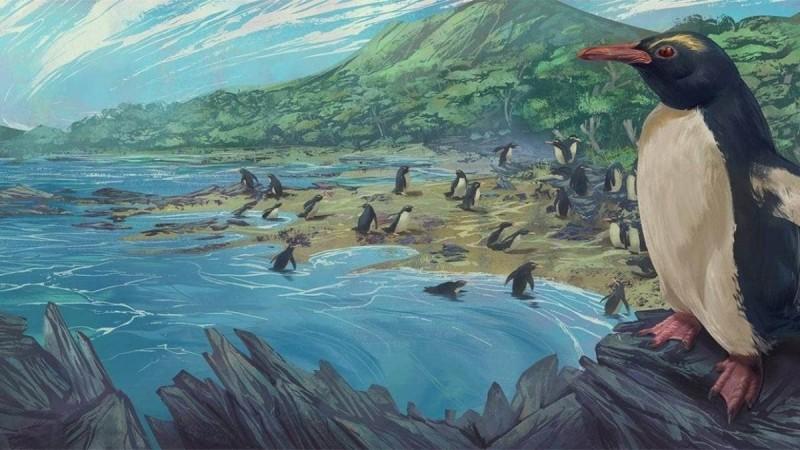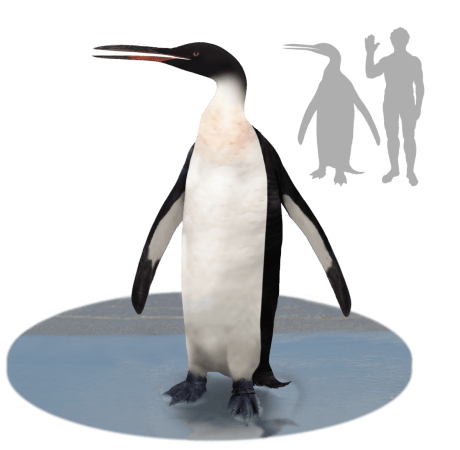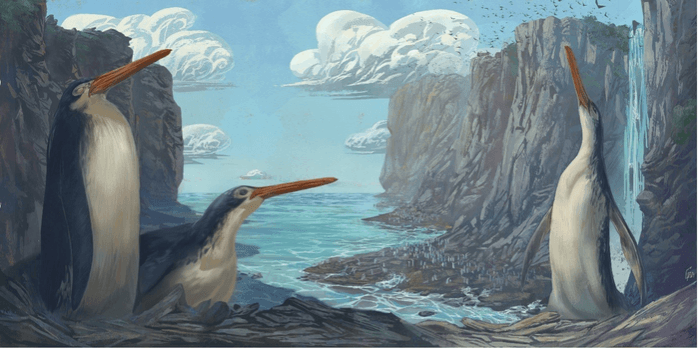With their characteristic waddle and flipper wings, penguins are some of the most adorable creatures in the world. These flightless birds come in different shapes, sizes, and colors, and different species are found on either side of the equator. The Emperor penguin, however, is the largest of all extant species at 1.1 m (3.7 ft). Now, scientists have unearthed the fossil of an extinct species that dwarfed Emperor penguins.
In a new study, researchers from Massey University and Bruce Museum (USA) have described a penguin that stood around 1.4 m (4.6 ft) tall and lived about 34.6 million to 27.3 million years ago during the Oligocene period. Named Kairuku waewaero, the giant penguin's fossils were discovered by a group of school children in New Zealand's Otago region. Waewaero in Māori means 'long legs', was given to the bird on account of having longer legs compared to similar species from the time.
"Finding any fossil is pretty exciting when you think about how much time has passed while this animal remained hidden away, encased in rock. Finding a giant penguin fossil though is on another level. As more giant penguin fossils are discovered we get to fill in more gaps in the story. It's very exciting," said Taly Matthews, a member of Hamilton Junior Naturalist Club (JUNATS), the group that helped find the fossil, in a statement.
New Zealand's Ancient Penguins

While dinosaur fossils tend to steal the thunder more than often, Penguins boast of a fossil record that goes back as far as the era of dinosaurs. New Zealand, or Aotearoa, as it is known in Māori, has served as the site of discovery of the earliest species of penguins. Most of these penguin fossils have been found in the Otago and Canterbury (such as Kairuku grebneffi and Kairuku waitaki) in New Zealand's South Island.
Importantly, till the unearthing of Kairuku waewaeroa, K. grebneffi and K. waitaki were the only two known species in the extinct genus Kairuku. However, several crucial findings have been made in the Taranaki and Waikato regions (such as the three-million-year-old dawn crested penguin Eudyptes atat) of the country's North Island in recent times.
Stumbled Upon By School Children

The fossil of K.waewaeroa was discovered by a group of school children in 2006—who were on a fossil-hunting field trip—in Kawhia Harbour, a fossil rich area in the Waikato region. Chris Templer, a fossil expert with JUNATS, led the group of children on the trip. The giant penguin's remains were kept at the Waikato Museum (Te Whare Taonga o Waikato).
A team of researchers from the Bruce Museum and Massey University examined the fossil. 3D scanning was employed and the fossil was compared to the digital forms of bones from across the world. The utilization of 3D scanning enabled the creation of a 3D-printed replica of Kairuku waewaeroa's fossil. JUNATS donated the real penguin fossil in 2017 to the Waikato Museum
'Long-Legged' Giant Bird

So how old is the fossil? According to Dr. Daniel Thomas, co-author of the study, it is between 34.6 million to 27.3 million years old. It belongs to a period when most of the Waikato region was underwater. He explained that that the newly identified species is similar to other species in the genus such as the K. grebneffi and K. waitaki that were found in the Otago region in New Zealand's South Island. However, it has longer legs. Hence, the name 'long legs'.
"These longer legs would have made the penguin much taller than other Kairuku while it was walking on land, perhaps around 1.4 metres tall, and may have influenced how fast it could swim or how deep it could dive," stated Dr. Thomas.
Pointing towards the potential of the discovery in fostering conservative temperament in children, Dr. Thomas added, "Kairuku waewaeroa is emblematic for so many reasons. The fossil penguin reminds us that we share Zealandia with incredible animal lineages that reach deep into time, and this sharing gives us an important guardianship role. The way the fossil penguin was discovered, by children out discovering nature, reminds us of the importance of encouraging future generations to become kaitiaki [guardians]."














